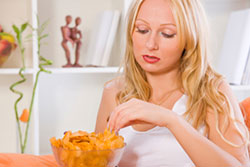Back to the February Issue
Too Much, Too Little:
Recognizing Disordered Eating Habits
By Emily Glover
In college, students are typically faced with many challenges, some rewarding, and others that give new meaning to the word “stress.” There are many productive ways to deal with pressure and change, but there is also a fine line between being healthy and going too far. What if your strategies, like developing extreme eating and exercise patterns, are causing more harm than good?
Kaitlyn describes disordered eating habits. (MP4, 03:09)
Desperate for Control
Here’s how I used to deal with the pressure I felt: I limited the amount of calories I consumed and worked out incessantly.When I moved away from my family support system to begin college, I had a strong desire to control one or two aspects of my life. With a schedule full of difficult classes, wanting to connect with new friends, and a lack of self-confidence, I was striving to feel “together” and successful in whatever way I could. So I began cutting calories and devoting myself to a one-hour workout each day. Although I really didn’t need to shed any pounds, I felt a sense of accomplishment—particularly because I believed I was dieting in a healthy, admirable way.
By the time my sophomore year began, there was a noticeable shift in my priorities. Whereas academics used to dominate my schedule, my new routine revolved around working out, looking for health tips, and planning my meals. My social life began to drop off as I turned down offers to eat with friends.
Though my relationship with food felt like an experience that other people wouldn’t understand, I later learned that my behaviors fell under a large umbrella of disordered eating patterns.

Identifying Unhealthy Eating Habits
While my eating disorder began with restricting calories and devoting excessive time to exercise, a person can have detrimental eating habits and a distorted body image without full-blown symptoms of an eating disorder. These patterns can be exhibited by both men and women and by people of all ages, backgrounds, and identities.Jenna Volpe, a registered dietitian who works with eating disorder patients in Waltham, Massachusetts, says there are common signs that someone is developing unhealthy patterns.
To find out what they are, CLICK HERE.
You might identify yourself doing any of these, or notice a friend or peer behaving in a way that concerns you. Volpe explains, “It’s best to recognize and address disordered eating patterns early on. Even if behaviors seem harmless or trivial, they have the potential to spiral out of control and [develop] into a clinical eating disorder if left untreated.”
Chad talks about his experience of anorexia. (MP4, 01:37)
Illuminating Other Concerns
Troubled eating habits are rarely stand-alone issues. Rather, they are coping mechanisms for dealing with change, anxiety, depression, and other difficult feelings.Vicki S., a sophomore at The Alamo Colleges in San Antonio, Texas, says, “Other causes may be fear of how others perceive us and feeling that we may not be accepted by other people.”
In a recent Student Health 101 survey, 69 percent of respondents said media messages contribute to perfectionism and self-consciousness about one’s body. Fifty percent noted fear of the “freshman 15,” while 54 and 42 percent attributed these feelings to academic pressures and emphasis on grades, respectively.
In my case, I felt anxious about my role in a large university. The ability to control the food I was, or wasn’t, eating gave me false confidence and masked the real issues in my life. Ann Chapman, a registered dietitian in Lawrence, Kansas, says, “[Getting] the eating disorder under control [is] like putting a bandage on a problem. Next time there is a major stressor, they’ll revert back.” My behaviors essentially allowed me to push my problems under the rug—so much so that they led to social isolation, too.

Helping Yourself or a Friend
It never crossed my mind that my eating or exercise habits were unhealthy or problematic. I was living in a dreamland where calories were bad and running just one more mile was a great accomplishment.Then I received an email from a trusted friend who said, “I know that you are simply doing everything that is associated with ‘being healthy,’ but done to an extreme, it’s dangerous.” My initial reaction was defensive: “I am being healthy!” I told myself. But doubt started to creep in.
Wanting to settle the matter, I set up an appointment with a nutritionist. I believed that this professional would support my diet and prove that I was healthy. But during that first meeting the nutritionist looked at me with sadness in her eyes as I described my miserly routine of small meals and big workouts. I asked her not to tell me my weight, but she informed me that it had fallen below the body mass index (BMI) range that is considered safe.
If you notice signs of disordered eating in a friend or family member, let that person know you are concerned and available to listen. If he or she is receptive, encourage your peer to meet with a doctor, nutritionist, or counselor. Many school health centers offer free or low-cost consultations.
As I began to address my behaviors, I never once harbored resentment against my friend. On the contrary, my friend’s willingness to reach out and help reminded me that people care about my well-being, and this motivated me to get healthy again.
Whether you are struggling with disordered eating or you recognize symptoms in someone else, know that this is a tale of hope. I now cook wholesome, balanced meals and I’m strong enough to have run four half-marathons.
I allowed myself to be vulnerable, and realized there is a fine line between being healthy and going too far. I slowly reengaged with my classes and friends, and rediscovered who I am.
I’ve also learned how to let loose. John K., a graduate student at the University of Florida in Gainesville, suggests joining a club that involves interacting with other people. “Your focus will be on having fun, yet working off the emotional discomfort.”
I’ve learned how to do this in ways that are beneficial for my body and mind. Life is good.
Take Action!
- Look out for early warning signs of disordered eating.
- Explore the intentions behind eating patterns to illuminate emotional concerns.
- Consider societal, academic, and personal pressures that impact how you feel about your body.
- Identify healthy coping strategies for managing stress and anxiety.
- Talk with a professional about feelings and eating patterns.
- If a friend is struggling, let him or her know you are available to talk.
EMILY GLOVER is a recent journalism graduate from the University of Kansas. She writes Pursuit of Healthfulness, a wellness blog.
Frequency of Disordered Eating In College Students
Using food and exercise as a way to feel a sense of control is common among college students, a group that experiences unique stressors.In a recent Student Health 101 survey, 64 percent of respondents said they had “eaten or not eaten in order to feel better emotionally” at some point in the past or present.
The National College Health Assessment, Spring 2012 indicates that of almost 91,000 college students across the United States:
- 87 percent of women and 80 percent of men were doing something to address their weight: to lose, gain, or keep it stable.
- In the last thirty days, 46 percent of women and 29 percent of men had dieted to lose weight.
- In the last twelve months, 26 percent of women and 14 percent of men found it “traumatic or very difficult to handle” something about their personal appearance.
Common Signs That Someone is Developing Unhealthy Eating Patterns
Jenna Volpe, a registered dietitian who works with eating disorder patients in Waltham, Massachusetts, says there are common signs of disordered eating.They include:
- Rigidity around timing or number of meals and snacks
- Excluding certain food groups or ingredients
- Excluding certain food groups or ingredients
- Regularly consuming excessive amounts of a food or beverage
- Categorizing food as either “good” or “bad,” “healthy” or “unhealthy”
- Avoiding situations that involve eating around others
- Overindulging or feeling a lack of control when eating (on a regular basis)
- Using diet pills, diuretics, laxatives, or excessive caffeine
- Exercising excessively to “make up for” eating
Contributing Factors To Disordered Eating
The causes of disordered eating behaviors are varied. So his how they play out.For women, this often means trying to be thin, while men feel pressure to be muscular. According to Tracy Tylka, assistant professor of psychology at Ohio State University’s Marion campus, this can “lead some to symptoms of eating disorders, pressure to use steroids, and an unhealthy preoccupation with weightlifting.”
According to Jenna Volpe, television and magazines definitely have an impact, as do misleading food labels, factors in one’s upbringing, and genetic predisposition. Plus she notes, “Pulling all-nighters and dining hall buffets don’t exactly promote a healthy relationship with food.”

